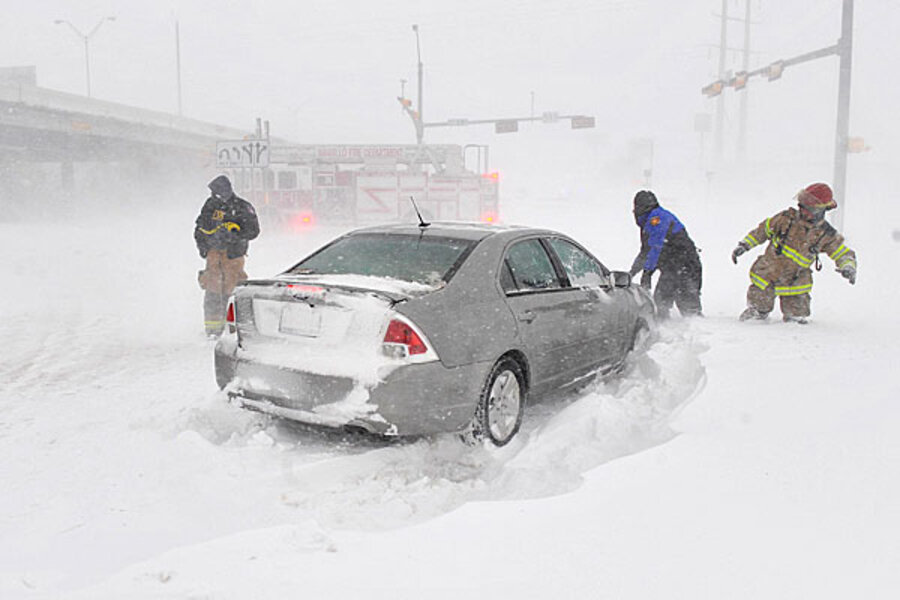Snowstorm snarls Kansas City airport, cuts power to 40,000
Loading...
| Kansas City, Mo.
The second major snowstorm in a week battered the nation's midsection Tuesday, dropping a half-foot or more of snow across Missouri and Kansas and cutting power to thousands. Gusting winds blew drifts more than 2 feet high and created treacherous driving conditions for those who dared the morning commute.
About 40,000 people in northwest Missouri and northeast Kansas awoke to no power as heavy, wet snow weighed on power lines. Kansas City, Mo., was in a state of emergency as blinding snowfall — made worst by sustained gusts estimated at 30 mph or higher — made car and truck traffic too dangerous. About 8 inches of new snow had fallen on parts of the Kansas City metro area as the sun rose Tuesday.
Flights in and out of Kansas City International Airport were canceled, schools, government offices and businesses across the region were closed. City buses were getting stuck.
Numerous accidents were reported in the area, and Mayor Sly James declared the emergency in an unwanted encore to a major snowstorm that dumped nearly a foot of snow on his city just five days earlier. He urged residents to stay home, given that the new storm was expected to dump nearly a foot of new snow on the city.
"This one has the potential to be quite serious," James said.
A strong low pressure system fueled the storm, which also included heavy rain and thunderstorms in eastern Oklahoma and Texas.
The storm knocked power out to thousands of homes in Texas and Oklahoma and was blamed for the death of a 21-year-old man whose SUV hit an icy patch on Interstate 70 in northwestern Kansas and overturned Monday. In Oklahoma, a person was killed after 15 inches of snow brought down part of a roof in the northwest town of Woodward.
In the Texas Panhandle, wind gusts up to 75 mph and heavy snow had made all roads impassable and created whiteout conditions, said Paul Braun, a spokesman for the Texas Department of Transportation. A hurricane-force gust of 75 mph was recorded at the Amarillo, Texas, airport. The city saw the biggest snowfall total in Texas with 17 inches.
Motorists were stranded throughout the Texas Panhandle, with the NWS in Lubbock reporting as many as 100 vehicles at a standstill on Interstate 27.
Schools and major highways in the Texas Panhandle remained closed for a second day Tuesday. State officials said they hoped that stretches of Interstate 40 near the Oklahoma border, which have been closed since Monday morning, would reopen by Tuesday afternoon. Whiteout conditions further impeded efforts to clear roads of more than a foot of snow in western Oklahoma early Tuesday.
Texas Tech's men's basketball team stayed overnight at a hotel in Manhattan, Kan., after playing Kansas State on Monday night, rather try to drive back to Lubbock. Also late Monday, officials with Oklahoma State University announced it would be closed Tuesday due to the weather.
The American Red Cross opened a shelter Monday night in Woodward, Okla., for stranded travelers. It also told its volunteers and workers in Kansas City to be prepared to help in the case of power outages or large numbers of stranded travelers.
Area hospitals closed outpatient and urgent care centers, and the University of Missouri canceled classes for Tuesday. The Missouri Department of Transportation issued a "no travel" advisory asking people to stay off affected highways except in case of a dire emergency.
Meteorologist Mike Umscheid of the National Weather Service office in Dodge City, Kan., said this latest storm combined with the storm last week will help alleviate the drought conditions that have plagued farmers and ranchers across the Midwest, and could be especially helpful to the winter wheat crop planted last fall.
But getting two back-to-back storms of this magnitude doesn't mean the drought is finished.
"If we get one more storm like this with widespread 2 inches of moisture, we will continue to chip away at the drought, but to claim the drought is over or ending is way too premature," Umscheid said.
_____
Associated Press writers Betsy Blaney in Lubbock, Texas, Nomaan Merchant in Dallas, Jill Zeman Bleed and Kelly P. Kissel in Little Rock, Ark., Daniel Holtmeyer in Oklahoma City, Steve Paulson in Denver, Paul Davenport in Albuquerque, N.M., and Roxana Hegeman in Wichita, Kan., contributed to this report.
Copyright 2013 The Associated Press.







